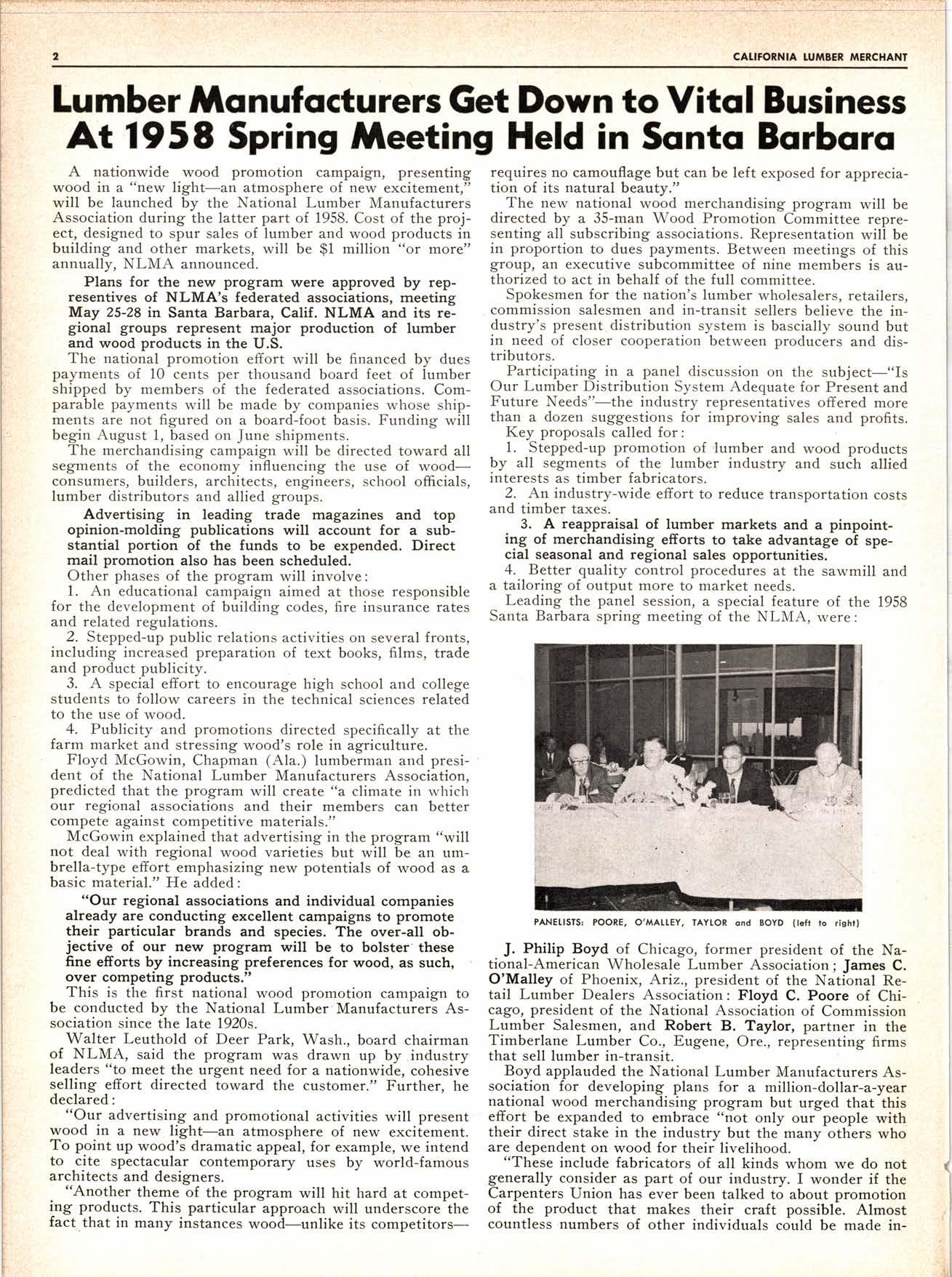
3 minute read
lumber ftlqnufocturers Get Down to Vitol Business At 1958 Spring lleeting Held in Sqntq Borboro
A nationwide wood promotion campaign, presenting wood in a "new light-an atmosphere of new excitement," will be launched bv the National Lumber Manufacturers Association during ihe latter part of 1958. Cost of the project, designed to spur sales of lumber and wood products in building and other markets, will be $1 million "or more" annually, NLMA announced.
Plans for the new program were approved by representives of NLMA's federated associations, meeting May 25-28 in Santa Barbara, Calif. NLMA and its regional groups represent major production of lumber and wood products in the U.S.
The national promotion effort will be financed by dues payments of l0 cents per thousand board feet of lumber shipped by members of the federated associations. Comparable payments will be made by companies whose shipments are not figured on a board-foot basis. Funding will begin August 1, based on June shipments.
The merchandising campaign will be directed toward all segments of the economy influencing the use of woodconsumers, builders, architects, engineers, school officials, lumber distributors and allied groups.
Advertising in leading trade magazines and top opinion-molding publications will account for a substantial portion of the funds to be expended. Direct mail promotion also has been scheduled. Other phases of the program will involve:
1. An educational campaign aimed at those responsible for the development of building codes, fire insurance rates and related regulations.
2. Stepped-up public relations activities on several fronts, including increased preparation of text books, films, trade and product publicity.
3. A special effort to encourage high school and college students to follow careers in the technical sciences related to the use of wood.
4. Publicity and promotions directed specifically at the farm market and stressing wood's role in agriculture.
Floyd McGowin, Chapman (Ala.) lumberman and president of the National Lumber Manufacturers Association. predicted that the program will create "a climate in which our regional associations and their members can better compete against competitive materials."
McGowin explained that advertising in the program "will not deal with regional wood varieties but will be an umbrella-type effort emphasizing new potentials of wood as a basic material." He added:
"Our regional associations and individual companies already are conducting excellent campaigns to promote their particular brands and species. The over-all objective of our new program will be to bolster-these fine efforts by increasing preferences for wood, as such, over competing products."
This is the first national wood promotion campaign to be conducted by the National Lumber Manufacturers Association since the late 1920s.
Walter Leuthold of Deer Park, Wash., board chairman of NLMA, said the program was drawn up by industry leaders "to meet the urgent need for a nationwide, cohesive selling effort directed toward the customer." Further, he declared:
"O_ur advertising and promotional activities will present wood in a new light-an atmosphere of new exciiement. To point up wood'J dramatic appeal, for example, we intend to _cite spectacular contemporary uses by world-famous architects and designers.
"Another theme of the program will hit hard at cornpet- ing products. This particular approach will underscore-the fact,that in many instances wood-unlike its competitors-- requires no camouflage but can be left exposed for appreciation of its natural beauty."
The new national wood merchandising program will be directed by a 35-man Wood Promotion Committee representing all subscribing associations. Representation will be in proportion to dues payments. Between meetings of this group, an executive subcommittee of nine members is authorized to act in behalf of the full committee.
Spokesmen for the nation's lumber wholesalers, retailers, commission salesmen and in-transit sellers believe the industry's present distribution system is bascially sound but in need of closer cooperation between producers and distributors.
Participating in a panel discussion on the subject-"Is Our Lumber Distribution System Adequate for Present and Future Needs"-the industry represeniatives offered more than a dozen suggestions for improving sales and profits.
Key proposals called for:
1. Stepped-up promotion of 'lumber and wood products by all segments of the lumber industry and such allied interests as timber fabricators.
2. An industry-wide effort to reduce transportation costs and timber taxes.
3. A reappraisal of lumber markets and a pinpointing of merchandising efforts to take advantage of spe- cial seasonal and regional sales opportunities.
4. Better quality control procedures at the sawmill and a tailoring of output more to market needs.
Leading the panel session, a special feature of the 1958 Santa Barbara spring meeting of the NLMA, were:
J. Philip Boyd of Chicago, former president of the National-American Wholesale Lumber Association; James C. O'Malley of Phoenix, Ariz., president of the Nati,onal Retail Lumber Dealers Association: Floyd C. Poore of Chicago, president of the National Association of Commission Lumber Salesmen, and Robert B. Taylor, partner in the Timberlane Lumber Co., Eugene, Ore., representing firms that sell lumber in-transit.
Boyd applauded the National Lumber Manufacturers Association for developing plans for a million-dollar-a-year national wood mercfianiiising program but urged that-this effort be expanded to embrace "not only our-people with their direct stake in the industry but the manv-othlers who are dependent on wood for theii livelihood.
"These include fabricators of all kinds whom we do not generally consider as part of our industry. I wonder if the Carpenters Union has ever been talked to about promotion of the product that makes their craft possible. Almost countless numbers of other individuals could be made in-










